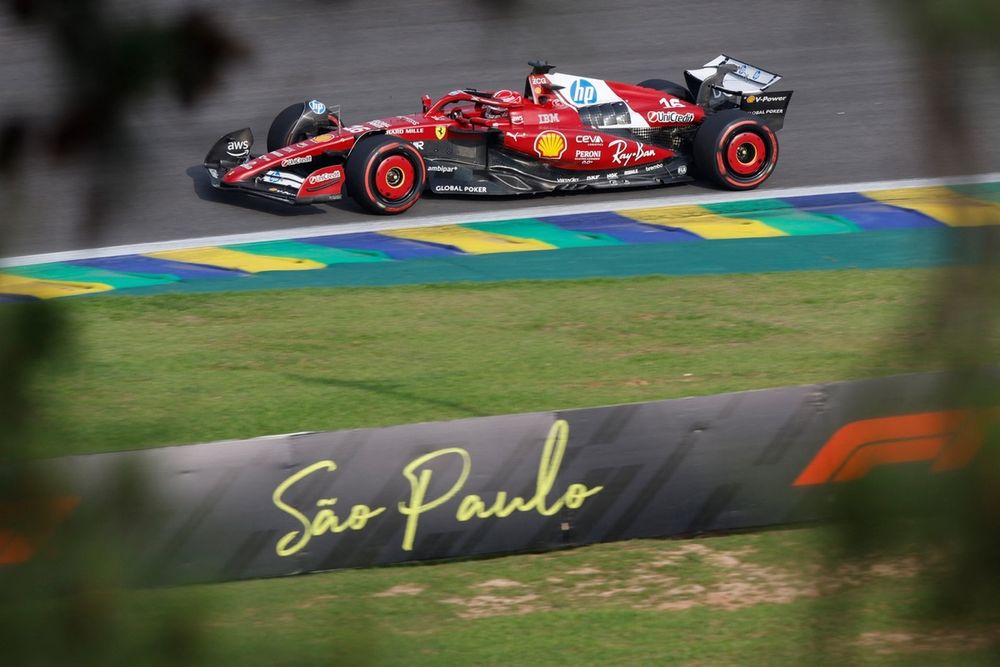A gyrating Ferrari was not an uncommon sight on Friday at Interlagos: Lewis Hamilton pulled a dramatic 720-degree spin when his SF-25 bottomed out at Mergulho in FP1.
This second sector at the Autodromo Jose Carlos Pace is characterised by bumps and changes of camber and gradient. Three corners earlier is where Hamilton’s team-mate Charles Leclerc spun in the second portion of sprint qualifying, bringing out yellow flags which then caused Hamilton to cross the finishing line after the chequered flag had been waved, so he lost any opportunity of going for another push lap.
But the fact remains that Hamilton was having a bad day anyway.
«It [the yellow flag] definitely didn’t help, but it’s not for the lack of trying,» said Hamilton after he was eliminated in SQ2. «The team thought we were a lot faster than we are and we gave it everything. And that’s ultimately what matters most, we just weren’t quick enough.
«I’m 11th now, so I just have to have some fun from there. I think at this point it’s literally just about having fun. It’s not going well for my side, my year, and I just have to just enjoy it wherever I am. And that’s all I can do.»
Hamilton was actually slightly quicker than Leclerc, lap for lap, through the early portion of sprint qualifying. But in SQ2 Leclerc’s first run, 1m09.732s, ultimately proved enough to progress to SQ3 even though he spun while trying to improve on it. Hamilton’s 1m09.811s left him outside the top 10, such are the fine margins in F1 these days. His next push lap was even slower – 1m09.934s – because of Leclerc’s spin, and he then arrived at the line too late to start another.
Charles Leclerc, Ferrari
Photo by: Lars Baron / LAT Images via Getty Images
It would be easy to lambast Ferrari for leaving it so late, but track evolution forces teams to operate at the margins of timing.
The build-up to Leclerc’s SQ2 spin is interesting because he has such a reputation for excellence in qualifying. In this case he came upon Isack Hadjar’s Racing Bulls car at precisely the wrong point on the lap, where Interlagos is at its tightest. You can see from the in-car footage how much he was hustling the car to get past before Turn 6, and his lap began to unravel from there: he was scruffy into Turn 7, went into Turn 8 far too hot, got on the dirty line on the outside, then spun as he mashed the throttle.
Ferrari has been fighting a baked-in car problem all season. The SF-25’s aerodynamic map is optimised around low ride heights it has been consistently unable to achieve in real-world running. Rear ride heights have been critical in the current ground-effect era because the majority of the downforce is produced by the underfloor, which requires an effective ‘seal’ at the floor edges to prevent air being drawn in from the side, reducing the suction effect.
What Red Bull understood straight away when the new rules came in for 2022 – because chief technical officer Adrian Newey’s first experience of F1 came in the previous ground-effect era – was that suspension kinematics have a powerful role to play in harnessing underfloor aero, mitigating the tendency of the negative pressure to induce porpoising and bouncing. That’s why Newey took a hands-on role in the suspension configuration of the first ground-effect Red Bulls; his transition to being hands-off and then out of the picture entirely has tracked in parallel to that team’s loss of form.
McLaren, and latterly Red Bull, have found a means of running their cars in a way which enables them to achieve a relatively low rear ride height without too much bounding at the rear, bottoming out, or excessive plank wear in that area. But even Red Bull hasn’t quite been able to achieve this consistently, as evinced by Max Verstappen’s struggles at Interlagos. This has always been a bumpy track.
Ferrari hasn’t been able to crack this secret, and raising the rear ride height has a very damaging effect on the SF-25’s pace. It’s significant that Leclerc’s qualifying pace plateaued – he found less than a tenth of a second in lap time when swapping from mediums to the soft-compound Pirellis for SQ3. Then his second push lap was slower, though this was caused by a gearbox issue unrelated to chassis dynamics.

Charles Leclerc, Ferrari
Photo by: Miguel Schincariol / AFP via Getty Images
«I’m not happy,» said Leclerc after qualifying eighth. «The car was very slow today. It didn’t feel that bad, but we are slow, so we’ve got something to work on and to try and improve for tomorrow.
«My lap in SQ3, the first one, was pretty good. [Then] I had a rejected downshift in the last straight, so we cost like a tenth and a half. But it wouldn’t have been much better.»
The silver lining for Ferrari was Hamilton escaped his yellow flag investigation with just a reprimand, having been judged by the stewards to have not been able to see the yellow flags as he was already past them when the signs were illuminated for Leclerc’s spin.
We want to hear from you!
Let us know what you would like to see from us in the future.
— The Autosport.com Team







